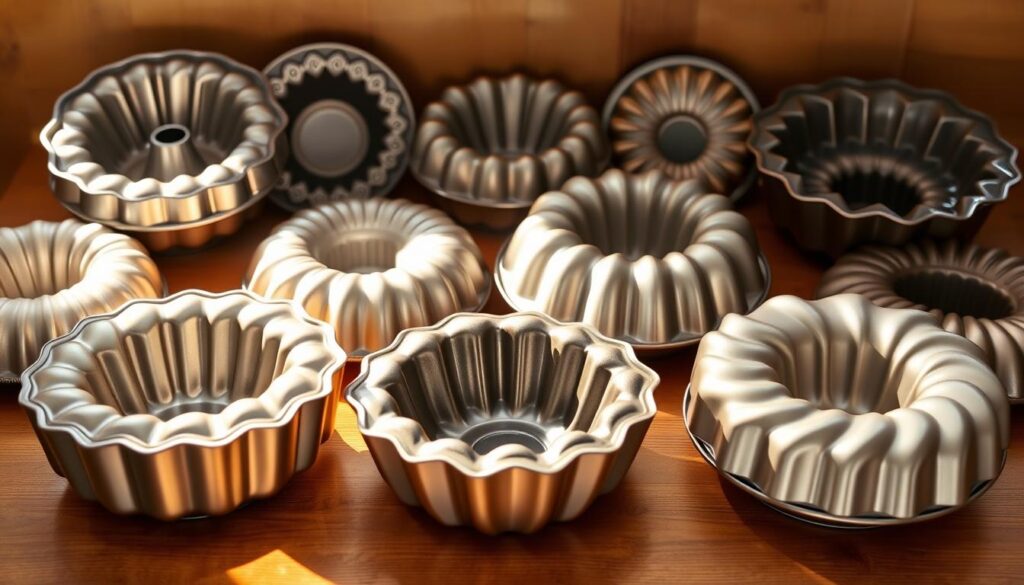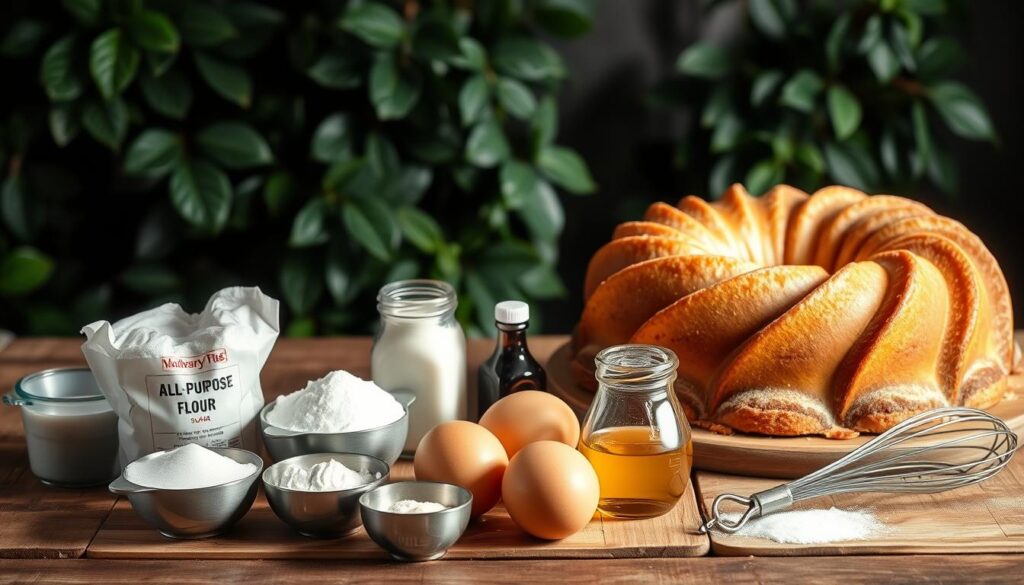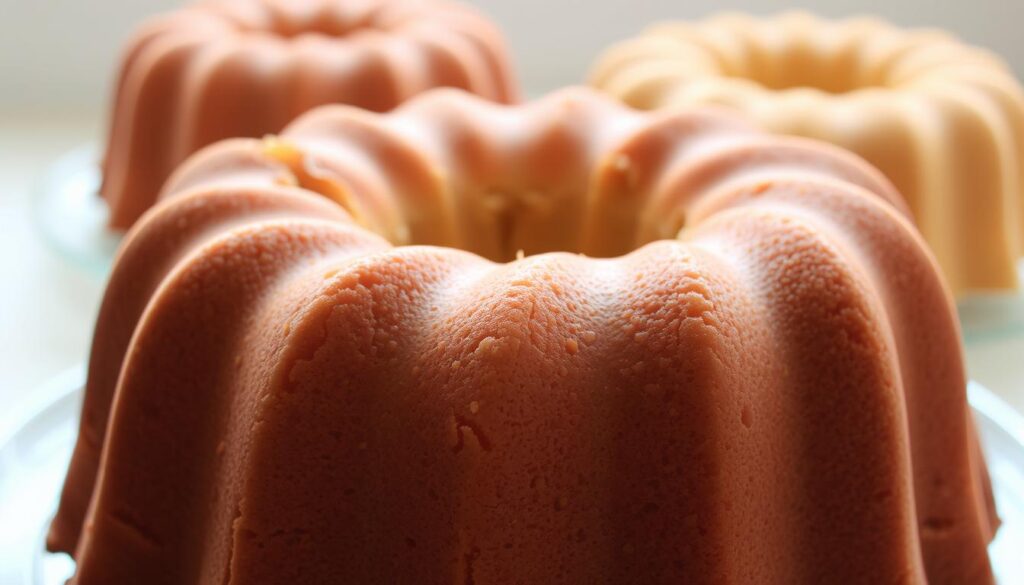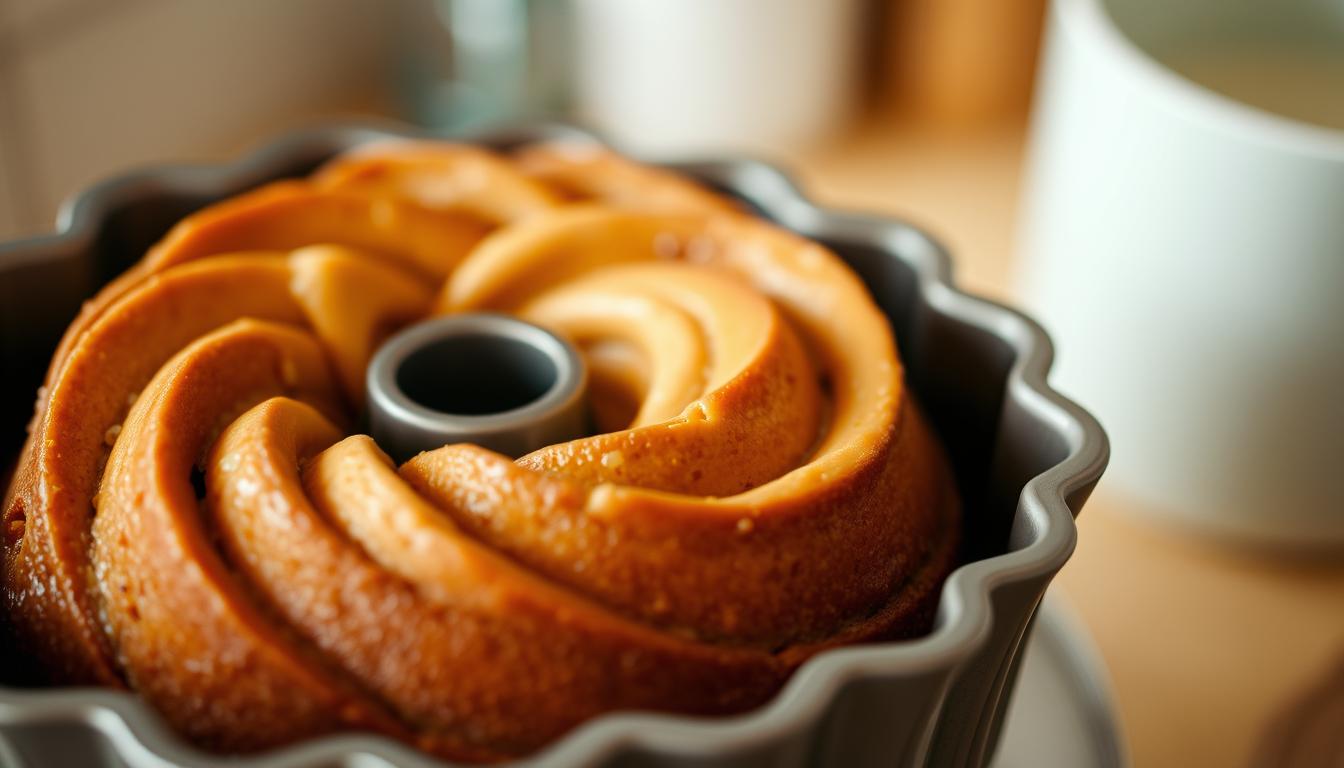Table of Contents
Baking is like magic, turning simple ingredients into a stunning dessert. Bundt cakes are a perfect example of this magic. They are a ring-shaped masterpiece that turns baking into an art.
Imagine pulling a perfectly golden bundt cake from the oven. Its distinctive shape shines with a light glaze, promising a rich, moist texture. These cakes are not just desserts; they are showstoppers that impress everyone.
In this guide, we’ll explore the world of bundt cakes. You’ll learn about choosing the right cake pans and mastering baking techniques. You’ll discover how to make delicious and stunning desserts that will wow your family and friends.
Key Takeaways
- Bundt cakes offer a unique ring-shaped design that makes baking impressive
- Proper pan selection is crucial for successful bundt cake baking
- Understanding ingredient ratios ensures moist and flavorful results
- Minimal decorating can create maximum visual appeal
- Precise baking techniques transform ordinary cakes into extraordinary desserts
The Rich History of Bundt Cakes: From Kugelhopf to Modern Times
The story of Bundt cakes is a captivating journey through time and across continents. It starts in the heart of European baking traditions. These cakes have a deep history that links old-world skills with today’s innovations.
Origins in European Baking Traditions
The story of Bundt cakes begins with the kugelhopf and gugelhupf cakes of medieval Europe. These elaborate desserts were common in German, Austrian, and French kitchens. They were baked in heavy stoneware molds, which gave them their unique ring shape.
- Traditional European bakers used intricate stone molds
- Kugelhopf cakes were popular in central European cuisines
- The distinctive ring shape allowed for even baking
The Nordicware Revolution
In 1946, Nordic Ware changed the game in baking. Founded by Dave and Dotty Dalquist in Minneapolis, they introduced the aluminum Bundt pan. This light pan replaced heavy stoneware, making home baking easier.
Evolution into American Baking Culture
In 1966, a Texan baker’s “Tunnel of Fudge” cake won second place in the Pillsbury Bake-Off. This led to a huge demand for Bundt pans, with over 200,000 requests. This moment made Nordic Ware a key part of American baking history.
Today, Nordic Ware has sold over 60 million Bundt pans. This shows how the Bundt pan has become a beloved American baking symbol. From its European roots to its modern American form, the Bundt cake still charms bakers and dessert fans.
Choosing the Perfect Bundt Pan for Success

Choosing the right tube pan is key for making beautiful molded cakes and ring-shaped desserts. Your Bundt pan can turn a simple recipe into a stunning centerpiece.
When looking for Bundt pans, several important factors will guide your choice. Let’s look at the essential considerations for baking perfect ring-shaped desserts every time.
Understanding Pan Capacity and Materials
Most home bakers need a Bundt pan with a 10 to 12-cup capacity. This size fits most recipes. The material of your pan is also crucial for success.
- Aluminum pans conduct heat well
- Cast iron retains heat well
- Nonstick surfaces make cake removal easy
Features of Quality Bundt Pans
Invest in a pan that will improve your baking. Quality tube pans should have:
- Durable nonstick coating
- Intricate design details
- Even heat distribution
| Brand | Weight | Capacity | Material |
|---|---|---|---|
| Nordic Ware Anniversary | 1.9 lbs | 10-15 cups | Aluminum |
| USA Pan | 1.11 lbs | 12 cups | Alloy Steel |
| Lodge Cast Iron | 9 lbs | 12 cups | Cast Iron |
Nordic Ware vs Other Brands
Nordic Ware is the top choice for Bundt pans. They invented the original Bundt pan and still make high-quality pans. While other brands are good, Nordic Ware’s quality is unmatched.
“A great Bundt pan is an investment in your baking future.” – Professional Baker
Always hand-wash your Bundt pan and avoid metal utensils to keep the nonstick surface. With the right pan, you’ll make stunning ring-shaped desserts that wow everyone.
Essential Ingredients for Moist and Flavorful Bundt Cakes

Creating the perfect Bundt cake starts with the right ingredients. Each part plays a key role in flavor and texture. This makes your baked goods stand out.
The base of a great Bundt cake is high-quality flour. Bakers mix all-purpose and cake flour for a tender crumb. Choosing and measuring ingredients carefully is crucial.
- All-purpose flour: Provides structure
- Cake flour: Ensures delicate texture
- Butter: Adds richness and flavor
- Sour cream: Delivers moisture
- Eggs: Bind ingredients together
Temperature is key when mixing ingredients. Butter and eggs at room temperature mix better. Pro tip: Remove dairy ingredients from the refrigerator 30-45 minutes before mixing.
The secret to a spectacular Bundt cake lies in understanding how each ingredient contributes to the final product.
For extra moisture, use sour cream or buttermilk. These add depth and make the cake tender. Try citrus zests, vanilla extract, or other flavors to make your cake special.
Mastering Bundt Cake Preparation Techniques
Getting better at baking is key to making a delicious Bundt cake. The right steps can turn a simple dessert into a special treat. Let’s explore the main techniques to boost your Bundt cake skills.
- Pan greasing methods
- Mixing and folding techniques
- Temperature control
Proper Pan Greasing Strategies
Keeping the cake from sticking is a skill in Bundt cake baking. Use baker’s nonstick spray or melted shortening on every nook and cranny of the pan. A standard Bundt pan can be coated with ¼ cup of unsweetened cocoa powder for easy release.
Mixing and Folding Wisdom
Start by mixing wet and dry ingredients separately. Mix them gently until just combined to avoid overworking. Make sure eggs and butter are at room temperature and cream them for about 5 minutes for the right consistency.
Precision Temperature Control
Bundt cakes are baked at 350°F for 55 to 60 minutes. Use the toothpick test to check if it’s done: if it comes out with moist crumbs, it’s ready. Let it cool for 10-15 minutes before flipping the pan.
Pro tip: Patience in baking techniques leads to perfect Bundt cakes!
Common Mistakes to Avoid When Baking Bundt Cakes

Baking a perfect Bundt cake needs precision and focus. Many home bakers face common errors that can ruin the cake’s texture and taste. Knowing how to fix these mistakes can help you make delicious desserts every time.
When you’re getting ready to bake your Bundt cake, remember these key points:
- Ingredient Measurement: Accurately weigh ingredients to prevent dense or dry cakes
- Flour Selection: Use the right type of flour for optimal texture
- Leavening Agents: Understand the difference between baking powder and baking soda
- Pan Preparation: Properly grease and flour your Bundt pan
One big mistake is adding too much flour. Bakers can add up to 50% more flour than needed. This makes the cake dry and tough. To fix this, use a kitchen scale for exact measurements.
It’s also important to know about your leavening agents. Baking powder and baking soda are not the same. Baking powder should be used within six months. You can test it by mixing it with hot water. If it bubbles, it’s still good.
Don’t forget about pan preparation. Use vegetable shortening instead of butter to prevent browning and sticking. For fancy Bundt pans, chill the pan before adding batter and dust it lightly with flour or sugar.
Pro tip: Fill your Bundt pan only two-thirds to three-quarters full to allow for proper expansion during baking.
By avoiding these common mistakes and using careful baking techniques, you’ll make beautiful, tasty Bundt cakes every time.
The Science Behind Perfect Bundt Cakes
Baking science is key to making amazing bundt cakes. It’s all about the chemistry that makes them taste and feel just right. Every home baker wants that perfect cake.
Knowing how ingredients work together is essential. Baking science shows how each part adds to the final cake.
Leavening Agents: The Magic Makers
Leavening agents are the secret to a great cake. They help the cake rise in different ways:
- Baking powder: Double-acting chemical leavener
- Baking soda: Needs an acid to work
- Getting the right amount is crucial
Flour Power: Understanding Cake Foundations
The type of flour you use changes the cake’s texture. Experts suggest:
- All-purpose flour for a solid base
- Cake flour for a soft crumb
- Blending flours for the best results
Temperature and Timing: Precision Matters
Baking needs to be precise. Temperature control affects how ingredients mix and the cake’s texture. Cooling for 10-15 minutes is key for a great cake.
Mastering cake chemistry turns amateur bakers into true culinary artists.
By grasping these scientific basics, you’ll make your bundt cakes truly special. They’ll impress everyone every time.
Decorating and Glazing Your Bundt Cakes
Turning your Bundt cake into a masterpiece is all about decorating and glazing. These cakes are stunning on their own, but a great glaze takes them to the next level. It makes your dessert even more delicious.
Begin with a glaze that matches your cake’s taste. A basic lemon glaze needs just three things:
- Powdered sugar
- Fresh lemon juice
- Milk or cream
Getting the glaze’s consistency right is key. It should be just right, not too runny or too thick. Bakers say to tweak the liquid and sugar mix to get it just right.
Glazing opens up a world of decoration. Here are some ideas:
- Try a chocolate ganache for a rich taste
- Use powdered sugar for a simple look
- Add fresh fruit for a pop of color
- Top it with cream cheese frosting for extra creaminess
Tip for decorating: Wait until your Bundt cake is completely cool before glazing. This keeps the glaze from soaking into the cake and gives it a pro finish.
The right glaze can turn a simple Bundt cake into a showstopper. It will wow your family and guests.
Storage and Serving Tips for Bundt Cakes
Keeping your homemade Bundt cake fresh and tasty is key. You need to know how to store it right and serve it beautifully. The right methods will keep your cake fresh and make it look great.
First, let your cake cool down properly. After baking, let it rest in the pan for 10-15 minutes. This makes it easier to remove. Then, place it on a wire rack to avoid moisture.
Freshness Preservation Techniques
Here’s how to store your cake:
- Store glazed cakes at room temperature for up to 2 days
- Cover tightly with plastic wrap or aluminum foil
- Avoid refrigeration, which can dry out the cake
- Freeze unfrosted cakes for up to 3 months
Innovative Serving Ideas
Make your Bundt cake stand out with these ideas:
- Dust with powdered sugar for an elegant touch
- Serve with fresh berries or whipped cream
- Create a simple glaze with vanilla or citrus flavors
- Pair with complementary dessert wines
Freezing and Thawing Tips
To freeze your Bundt cake, wrap it in plastic wrap and then foil. Thaw at room temperature for 2-3 hours before serving. Enjoy it within 3 months for the best taste.
Pro tip: Always let your cake come to room temperature before serving to enjoy its full flavor and texture.
Conclusion
Your journey in Bundt cake baking has turned into an art form. You’ve learned the techniques, history, and how to prepare them perfectly. This skill lets you make stunning desserts that wow everyone.
Every Bundt cake you make is a masterpiece of flavors and textures. You’ve tried seasonal treats like Pumpkin Spice and classic recipes. Your success comes from paying close attention to every detail.
Keep trying new flavors, techniques, and decorations. Your skills will grow with each cake you make. Practice makes you more confident, and each cake is a chance to get better.
Now, you can turn simple ingredients into amazing desserts. Your Bundt cake baking success is only limited by your creativity and desire to try new things.
FAQ
What is the difference between a Bundt pan and a regular cake pan?
A Bundt pan is shaped like a ring with fluted sides. It makes a cake look fancy. Unlike round pans, Bundt pans have a tube in the middle. This helps the cake cook evenly and rise better.
This design makes the cake look amazing. It has patterns on the outside that regular pans don’t have.
Can I use a metal spray instead of greasing the pan with butter or oil?
While baking sprays are easy to use, Bundt cakes do better with butter or shortening and flour. This mix makes sure the cake comes out of the pan easily. It covers every part of the pan, so the cake doesn’t stick.
How do I know when my Bundt cake is fully baked?
To check if it’s done, use a toothpick. Stick it in the middle. If it’s clean or has a little moisture, it’s ready. Also, the cake should pull away from the pan and feel springy in the middle.
Why did my Bundt cake stick to the pan?
Sticking can happen for a few reasons. Maybe the pan wasn’t greased enough or the wrong grease was used. Or, you might have taken the cake out too soon. Always grease the pan well and let the cake cool for 10-15 minutes before removing it.
Can I freeze a Bundt cake?
Yes, Bundt cakes freeze well. Wrap it in plastic wrap and then foil. They can stay frozen for up to 3 months. Let it thaw at room temperature for a few hours before glazing or frosting.
What’s the best way to store a Bundt cake?
Keep your Bundt cake in an airtight container or covered with plastic wrap. It stays fresh for 3-4 days at room temperature. If it has cream cheese frosting, refrigerate it and it will last a week.
Can I convert a regular cake recipe to a Bundt cake?
Most recipes can be made into Bundt cakes. Just make sure the recipe fits the pan size. Bundt cakes take longer to bake because they’re denser. Adjust the baking time accordingly.

